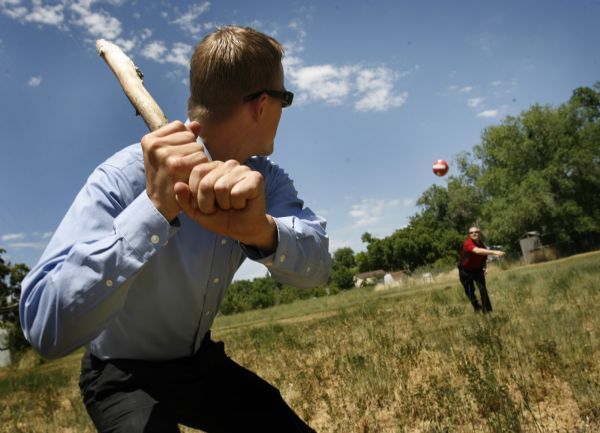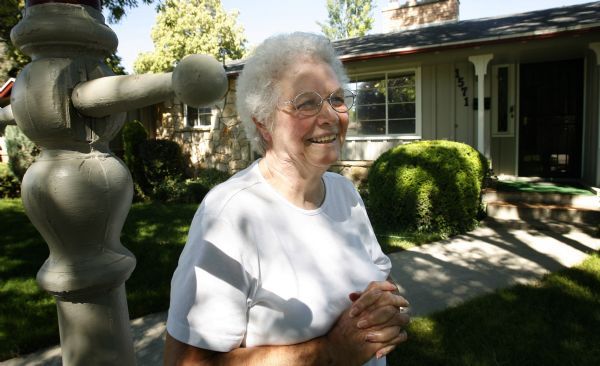This is an archived article that was published on sltrib.com in 2010, and information in the article may be outdated. It is provided only for personal research purposes and may not be reprinted.
The old ball field sits empty now, filled with weeds and accumulated trash.
It's hard to believe that less than two decades ago, boys of summer played here, swinging bats, chomping bubblegum, telling tall tales. They played baseball in a way kids don't anymore.
This nondescript patch of grass and hard dirt is hard to find even when you look for it.
But here, between Glenrose Drive and Navajo Street in Salt Lake City's Glendale neighborhood, filmmakers found their perfect setting for "The Sandlot," the 1993 classic about baseball, the simplicity of youth and the challenges of both. The film was centered around this now-deserted lot. It once again tells a deeper story, but now opens the door to a fundamental question: Why isn't the sandlot a sandlot any more?
Through the twisted gap in the fencing, to the northeast, is the film's left-center field, where Scotty Smalls caught his first fly ball. There, grass has grown hip high, creating a sense that this is where the outfield ends. The first-base line runs into a pile of styrofoam. The ghost of home plate, once shaded by the frames of young boys, is marked by the ragged remains of a soda bottle.
There are plenty of reasons this spot hasn't been enshrined in the manner of Iowa's "Field of Dreams" or become a neighborhood hangout as in "The Sandlot."
The field is privately owned, subdivided into five rectangular lots that stretch forward to Navajo Street, where they are anchored by modest homes.
Still, there are no beastly dogs on the other side of the fence frightening kids from entering. Neighbors say kids never play in the field, and at least one owner would like to see it used to fulfill the purpose for which it is most remembered.
"I would have no qualms against that," says Gerry Johnston, who less than a year ago bought the end of the lot where a baseball signed by Babe Ruth ball landed, just beyond a tall fence.
'A bit of nostalgia'
The story of "The Sandlot" has been tested by time and relevance, but remains unbruised.
We will always watch movies about friends growing together, preteen lust and the pre-eminent threat of the unknown.
And baseball.
The movie, set in 1962, has a spot on Baseball Almanac 's list of the top 10 baseball movies, giving it membership in an exclusive club that includes "Field of Dreams" and "Bull Durham."
"It's a bygone era and there's a bit of nostalgia," former Utah Film Commission director Leigh von der Esch says. "But I think it's beloved because of the nostalgia. It captures the dialogue of kids so well."
The movie was filmed entirely in Utah. Smalls and his friends, notably Benny "The Jet" Rodriguez, were shown to live in a neighborhood in Sugar House, at the elbow of 2000 East and Bryan Avenue.
During two days of filming on this quiet street, the child actors, ages 8 to 13, often just sat in front yards, away from film crews, talking and playing with the real neighborhood kids, says Jackie Nielsen, an excitable 77-year-old woman whose well-kept corner home was cast as Benny's house.
Still, the child actors needed methods to connect time.
One stand-in sat with Nielsen in her living room, playing Nintendo.
Times have changed
Mike Vitar is a Los Angeles firefighter today, but he was Benny the Jet during filming in 1992, and will be for as long as young boys and families sit in front of television sets.
Vitar came of age in time to see freedom slip away from kids.
He and his friends played baseball on the few remaining lots in West Hollywood, where they swung at a tennis ball -- as a courtesy to neighbors' windows.
"There is something to be said about a group of kids being able to get together and being able to hang around all day without any kind of structure," Vitar says. "Getting into a little bit of trouble."
Vitar is now a parent, and says getting into trouble is no longer a harmless pursuit.
"Innocent fun, you could call it," Vitar says. "It just isn't that anymore."
Therein, perhaps, lies the reason that an empty field in the middle of an urban neighborhood goes untouched, says Nicole Lavoi, a University of Minnesota professor who is an expert on youth sports and co-founder of the Minnesota Youth Sport Research Consortium.
"There's an increased parental belief that kids doing free play outside are not safe in their own communities," Lavoi says. "We have turned more toward structured, organized youth activities instead of sending them out into their communities."
In 2009, Little League Baseball reported 2.9 million boys and girls between ages 5 and 18 played in its leagues, not to mention countless other organizations and associations for youth baseball.
Lavoi also pointed to the proliferation of video games for the disappearance of sandlot baseball. Children spend an average of 53 hours a week consuming electronic media, according to a study by the Kaiser Family Foundation released earlier this year.
Open space -- a persistent political battle -- has become more and more scarce, making the casual game, and the expectation of a place to play it, a memory.
"You can't just go and find an open field that isn't locked up and just use it," says Kellen Jensen, the program coordinator at the Millcreek Activities Center, who played national-level baseball growing up in Utah.
"I can't think of a single time in my life that I played baseball that wasn't organized," the 24-year-old youth sports coordinator says.
Honor it or move on?
Marshall Moore, the executive director of the Utah Film Commission, quickly points out that "The Sandlot" is his favorite movie made in Utah, which explains his insistence on further propagating its legacy here.
It also explains the Brooklyn Dodgers jersey, emblazoned with "Rodriguez" on the back, he wore to a screening of the film last month on the lawn at the Capitol.
He's not alone. The movie drew more than 1,000 people on a Thursday night.
The 20th anniversary of the 1993 film is approaching. Moore and others look at the barren old sandlot and see what others haven't in the 18 years since film crews left: opportunity.
"It's our own baseball kingdom," Moore says.
The film commission has big dreams of honoring the approaching 20th anniversary of "The Sandlot."
Moore imagines a 2013 summer evening with a film screen positioned on the sandlot -- with each owner's permission, of course -- repurposed to resemble a ball field once again. It's filled with locals eager to connect what they see to where they are. The cast is there, all the main characters: Smalls, Squints, Ham, Yeah-Yeah.
And, yeah, Benny.
Except Vitar says he probably wouldn't attend. He's 31 now and has a family. His role as a fictional hero has been left far behind. Instead, he drives the No. 9 fire truck in L.A.'s Skid Row area.
He says he hasn't watched "The Sandlot" since its release and that he keeps no memorabilia from the film. His acting career extended into the final two installments of the "Mighty Ducks" trilogy, but was over by 1997.
He owns a copy of "The Sandlot," though. His wife shows it to their two sons when Vitar is on overnight shifts at the firehouse.
Even if his young sons watch the movie and are inspired to get outside and play baseball with neighborhood kids, Vitar will put his foot down.
"You can't let your kids run free anymore," he says.
But, he proudly adds that his oldest son has learned to hit underhand pitches. That is exciting for the man who may be best remembered for busting the guts from a baseball on a small field in Utah.
"We definitely will be putting our oldest in T-ball next year," he says.
In 1992, the Utah Film Commission was successful in bringing the production of "The Sandlot" to Utah. "It was just a great script," then-commissioner Leigh von der Esch said. She rented a plane to search the Salt Lake Valley for something that would work for the titular field, eventually spotting an empty lot in Glendale. The movie has become a favorite to baseball fans, kids and families -- and it was filmed entirely in Utah. In addition to the Glendale lot, scenes were shot in Sugar House, Midvale, Ogden, Rose Park and Liberty Park.







